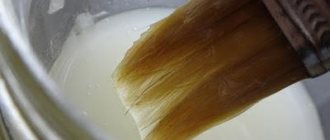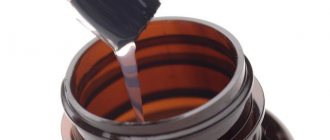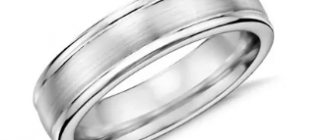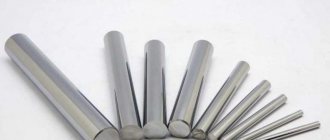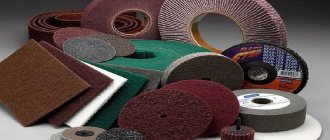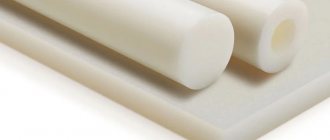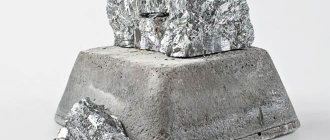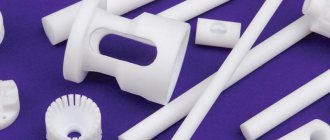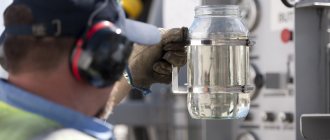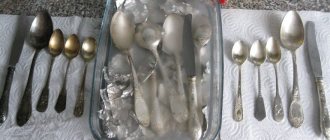Bone glue in most variations is an appropriate base based on organic components. They allow you to effectively connect elements made of wood, cardboard, hardboard and other similar materials. The connection itself is characterized by maximum strength; even if the structure is destroyed, you can notice that it is not the adhesive layer that is deformed, but the adjacent layers of wood or analogues. The mixture in question includes safe organic components that are approved for use in educational institutions and children's rooms.
Preparation
The operating algorithm can be derived as follows:
- The glue is prepared according to the above method, with precise control of the cooking temperature.
- All bonding surfaces must be dry and clean. The maximum moisture content for wood is no more than 10 percent (veneer - half that).
- The adhesive mass is applied with a bast or bristle brush to both surfaces, the thickness of the seam is 0.1-0.2 mm.
- You need to wait three minutes. This will allow the adhesives to grip securely and not be squeezed out when connecting the parts.
- After fixing the elements, you will need to grind them together.
- It is advisable to tie the parts to be processed with twine or compress them with a clamp.
- Full use of the product is allowed no earlier than after six hours of exposure.
Rating of the best wood adhesives
Professionals prefer to purchase adhesives from well-known brands: “Titan”, “Titebond” (Titebond), “Moment”, etc. Different categories have their own leaders who break purchasing records.
PVA based glue
This group of adhesives is the most popular; it includes a huge number of names from domestic and foreign manufacturers. Here are examples:
- Kleiberit 303.0. The German product is highly water resistant and allows you to join parts from all types of wood, veneer, fiberboard and chipboard. Requires a short fixation time for products - only 6-10 minutes. The glue is resistant to low temperatures and has a white color. Advantages: ease of use, resistance to atmospheric factors and water. The disadvantage is the higher price.
- "Moment Joiner Instant Grip." It is a universal product based on acrylic dispersion, which is capable of not only gluing wood efficiently, but also filling cracks and defects up to 5 mm deep. It does not contain solvents and is ideal for all types of wood. Advantages: transparency after drying, easy application, fast drying, high initial adhesion. Disadvantage – unsuitability for some types of plastic, Teflon, poor resistance to moisture.
- "Ultima Joiner PVA". The product is distinguished by its high seam strength; it can be used to glue even those products that are subject to dynamic loads. The glue is not destroyed by low temperatures (up to -35 degrees), and can withstand 4 freezing/thawing cycles. Pros: versatility, frost resistance, seam strength. The downside is long drying time.
Polyurethane adhesives
Such products belong to the professional line of wood adhesives; they are most often used in furniture production. Examples of quality compositions:
- "PUR-glue 501". Waterproof adhesive of category D4, used for gluing wood, windows and doors, building materials. This reactive adhesive hardens when exposed to moisture, withstands high loads, and is heat resistant. Advantages: easy application, high pot life, short curing time, plasticity. Disadvantage: high price, brown color.
- Titebond Polyurethane Wood Glue. The glue retains its working properties for 20 minutes and perfectly connects any products made of wood and wood-based materials. It is not afraid of frost, it only needs to be warmed to room temperature before use. Pros: suitability for different materials, highest degree of adhesion. Disadvantage: difficult to find, high price.
- Soudal 66A. It is used to connect wood with any other materials except polypropylene. It is highly moisture resistant and can glue even wet products. Due to foaming, it penetrates into small crevices and reliably fills all defects. Pros - wide temperature range of application, high adhesion, disadvantages - strong expansion after drying.
Resin-based wood adhesives
The products contain epoxy or polyester resin, as well as a number of other synthetic components. Here are the best in the ranking:
- UHU PLUS ENDFEST 300. The strongest epoxy composition, its setting time is 1.5 hours, the time for complete curing of the seam is 12 hours. Advantages: impact strength, water resistance, durability of the seam. Disadvantages - the need for strict adherence to proportions.
- EDP. An epoxy composition at an attractive price, allowing you to make furniture and repair it. It has high adhesion and water resistance. Pros: the ability to introduce fillers, availability, cost-effectiveness, lack of shrinkage. Disadvantages - inability to use for products in contact with food, long drying time.
Professional wood glue
Of the variety of wood glues, professionals highlight Tightbond 3 Ultimate. It is one-component, water-resistant, and stains can be cleaned with water. The material has a high initial adhesion. A dry joint can even be sanded without risk of structural damage. The glue does not harm humans, can be used for products in contact with food, and is suitable for interior and exterior use. No shortcomings were found in the product.
By choosing high-quality glue, you can be confident in the strength of the connection between the parts and the long service life of wooden products, so when purchasing, it is better to choose a product from trusted brands!
Enogelatin TU U 24.6-00418030-006:2011
Gelatin is a good clarifier for various wines that are prone to browning or exhibit light turbidity that is difficult to remove by filtration, caused by the action of excess tannins.
Enogelatin is gelatin obtained from a hot gelatin solution through special processing under optimal conditions. Release form: powder and liquid. The drug is approved for use in accordance with current legislation.
Technical consultation
| The name of indicators | Characteristics and standards for brands | ||
| A | IN | WITH | |
| Appearance | Grains, powder, solution, granules, plates | ||
| Color | Colorless to amber | ||
| Smell | No foreign odors, the smell of sulfur dioxide in liquid gelatin is allowed | ||
| Taste | Fresh | ||
| Mass fraction of dry substances (for solution), % not less | 10 | ||
| Dynamic viscosity of enogelatin solution with a mass fraction of 10%, mPa*s, no more | 5,0 | 2,5-5,0 | 2,5 |
| Indicator of activity of ions of an aqueous solution of enogelatin with a mass fraction of 1%, units. (pH) | 4-7 | ||
| Mass fraction of sulfurous acid in terms of SO2%, not less | 0,5 | ||
Enogelatin brands:
- A-low hydrolyzed enogelatin;
- B-enogelatin of medium degree of hydrolysis;
- C-highly hydrolyzed enogelatin.
Properties of enogelatin:
- It has a higher efficiency of interaction with phenolic compounds than regular gelatin when processing beverages and wine materials.
- The tannin-precipitating ability of enogelatin is several times higher than that of edible gelatin, which makes it possible to effectively process even highly extractive red wine materials that are difficult to fining, improve organoleptic qualities and ensure long-term stability of drinks.
- Enogelatin in powder form dissolves easily, without lumps, in cold wine materials. Liquid enogelatin allows it to be used without prior preparation, adding it directly to the material being processed.
- The low gelling ability of enogelatin makes it possible to process wines stored in open areas, as well as to combine fining with cold treatment.
- Enogelatin is used in conjunction with mineral sorbents - bentonite or a colloidal solution of silicon dioxide; if necessary, tannin can be included in this scheme. When using enogelatin, the amount of mineral sorbents is halved.
- Treatment of table and fortified wine materials with enogelatin ensures their transparency and the necessary resistance to colloidal opacities, helps to preserve the typical color and bouquet, the formation of a harmonious taste, and does not introduce any extraneous shades into the taste and bouquet of wine.
Application of enogelatin:
The optimal dosage is determined based on a trial treatment (pasting).*
For standard fining you need enogelatin: - dry commercial form (powder) - 0.2 kg per 1000 decalitres; — liquid commercial form: a) 1 liter per 1000 dal (for white, table and vintage wines); b) 2 liters per 1000 dal (for red and fortified wines).
* according to the technological instructions for processing wine materials with enogelatin TI 00011050-1272-2011, developed by the National Institute of Grapes and Wine “Magarach” of the National Academy of Agrarian Sciences of Ukraine.
Enogelatin packaging:
containers made of plastic or other materials approved for packaging food products weighing from 5-50 kg.
Shelf life of enogelatin: 1 year.
Bonding technology
For strong bonding, it is necessary to create reliable pressure on the parts being glued. Various devices are used for this. Various clamps are commercially available, and some devices can be made independently. In the first case, two rigid plates and four bolts
. But for gluing large parts, four clamping bolts are not enough. In this case, the press can be replaced with a set of separate linear clamps.
As the size of the shield increases, the number of clamps must be increased. They must be placed at a distance of no more than 200-250 mm from each other. Choose bars 25-30 mm thick and 50-60 mm wide. Bolts should have a diameter of 8-10 mm and a length of 200 mm. The pressing edge of the bars must be made flat, then when they are tightened, the curved edge will straighten and create pressure along the entire length. It is better to clamp identical slabs together at the bottom. Then each of them serves as a kind of press for the other and provides uniform pressure
. The nuts on the bolts must be tightened alternately at both ends. It is better to stick the cladding only on one side of each frame, the one that comes into contact with the adjacent one.
The moisture content of the glued wood and wood materials should be 6-10%, maximum 14%, i.e. Only dry wood can be glued. The surfaces to be bonded must be flat and smooth (roughness up to 200 microns is allowed). This surface quality is ensured by processing with a plane
, grinding, planing on machines.
When gluing, it is enough to apply the glue to one of the surfaces to be glued. Apply glue with a brush. Duration of gluing, i.e. exposure of workpieces under pressure depends on the gluing method (hot or cold), the thickness of the workpieces and the temperature of the heater (for hot gluing), and the brand of glue.
When covering panels with sliced veneer, glue sometimes seeps through the thin veneer onto the front surface. The main reasons for this defect are liquid glue, high consumption, and high pressing pressure. Therefore, when performing facing work, it is necessary to strictly comply with the regulatory requirements for these parameters.
Another common defect when lining thin sheets or panels is their warping. It is especially large with one-sided cladding, i.e. when the law of symmetry is violated. Therefore, cladding of shields
always done on both sides. Single-sided cladding is permissible only for thin sheet materials (plywood, fiberboard), but on the condition that parts from them will be fixed in the product, such as, for example, the back walls of cabinet furniture.
After gluing parts, lining them, or assembling a product using glue, a technological holding period is required. Its duration is at least a day. The panel parts are kept on level ground in tight stacks, while the top panel is loaded. The assembled product is kept on the floor
. Technological exposure is necessary so that the glued parts cool, the adhesive joint gains strength and the internal stresses in the adhesive joints decrease. By holding parts in a clamped position, their shape is stabilized, and only in this way can subsequent warping be avoided.
PVA carpentry glue - characteristics
PVA-based wood glue is sold ready-made; there is no need to dilute it in water. Ideal for working with hardwood, including tropical wood. The resulting seam is not afraid of moisture, it is durable and transparent.
It is used everywhere; the rapid development of technology and the emergence of new offers on the market do not prevent it from being in demand.
Among analogues, we can offer Moment carpentry glue, it is suitable for wood and plastic, sets quickly, and is very durable.
There are several ways to make wood glue with your own hands, but they are all based on the same principle - soaking and cooking in water.
To make wood glue with your own hands, you need the following ingredients:
- yellow granules or solid glue tiles (the lighter the starting material, the better the composition will be),
- boiled water,
- tile,
- glue for cooking.
Wood glue recipe
- Wrap the glue tiles in cloth and break them with a hammer.
- Pour the crushed source material with cold water so that it completely covers the dry glue. It should turn into a gelatinous mass. On average, this takes 4-12 hours. The water must be boiled.
- Place the swollen composition in a water bath and cook for about 15 minutes at a temperature of 60-80C, stirring constantly. All lumps should dissolve, the mass will be homogeneous and liquid.
- It is most convenient to boil the glue in a special glue pot made of two vessels. Water is poured into a larger vessel, and glue is placed into a smaller vessel and placed inside the larger one. The oilcloth is placed on the fire and the composition is boiled.
- During cooking, hot water can be added to obtain the desired consistency. If you are gluing tenon or end joints, the composition should be a little thicker than for working with plywood and other flat materials.
- As soon as a film appears on the surface, the wood glue can be considered ready. The composition should flow from the stick not in drops, but in a continuous stream.
You need to use the glue before it has cooled down, and the glue retains a temperature of 30-70C for one and a half to two hours without additional heating. As the solution cools, it will lose its properties, and then may even become moldy or begin to rot.
Option two
- Another way is when glue and water are mixed in a one to one ratio,
- Boil, and the resulting mass is ground,
- Then put it on a plate and cut into pieces.
- Immediately before starting repair work, such a workpiece is dissolved in a mixture of water and vodka and boiled.
- While preparing the composition, you can add table vinegar to the water and glue, and when the powder is completely dissolved, add vodka.
Various components are added to wood glue to impart new properties, for example, linseed oil or drying oil mixed with dry powder will increase the resistance of the adhesive joint to moisture, and if you have to work with leather, add glycerin.
The glue will retain its consistency at room temperature for no more than two hours, and then it will begin to thicken. Then you will have to reheat it again. In this regard, it is better to prepare the composition not in reserve, but only in the quantity that is required.
When we start a renovation, first of all, we carefully select high-quality materials for construction. However, it often happens that building materials are of low quality or simply not suitable for repairs. If you find yourself in such a situation, do not despair, because for every question there is an answer. In this article we will talk about making wallpaper glue at home.
Recently, repairs and everything that is required for them are costing very large sums. This is due to the fact that prices for building materials are rising sharply, and the quality of materials is only getting worse. Therefore, many people prefer to do on their own what can be done at home. Wallpaper glue is not so difficult to make if you know the correct procedure and the ingredients from which it is prepared. Wallpaper glue is made from different components. We will describe all these methods in detail in this article.
Recommendations
You can prepare glutinous glue yourself. To do this, you will need to take two containers of different sizes. The outer shell could well be a tin can. Insert a tin can attached to a wire inside it.
The quality of the adhesive composition can be improved by adding various fixing substances. This will allow you to use glue for fastening not only wooden surfaces, but also other analogues.
Among the components used, the most popular, along with efficiency, are the following materials:
- Drying oil. About 10 grams of linseed oil or 40 granules of natural drying oil are added to the composition. This component allows you to increase the resistance of the working seam to moisture.
- Glycerol. An equally effective component makes it possible to use glue when processing leather surfaces. Added at the rate of two teaspoons per liter of finished substance.
- Chalk powder combined with wood ash. After sifting this mixture, add it in small quantities. The paste improves putty properties,
- Phenol, ammonia, borax. These components are an excellent antiseptic that prevents the formation of fungus and mold.
The best resin wood glue
Moment joiner
Glue from a domestic company, developed on the basis of epoxy resin. Allows you to reliably connect surfaces made of MDF, chipboard, plywood, wood of various species, as well as plastic with paper inclusions. The parts to be glued are pressed using a vice or clamp for 15 minutes to set.
Complete polymerization takes 24 hours. The composition does not change the color of the materials being glued (this helps to expand the scope of its application). The recommended temperature range for effective use of the product is +5 - +30 degrees.
Pros:
- transparency after drying;
- ease of use;
- quick and reliable setting, strong fixation;
- minimum time for polymerization.
Cons: low moisture resistance.
Titebond II Premium Wood Glue 5005
One-component composition for gluing wooden parts. The product has good water resistance. Can be used for repairing garden furniture, making birdhouses (birdhouses, titmouses), and mailboxes. The adhesive composition sets well, hardens quickly, forming a reliable seam. To increase the durability of the structure, it should be coated with waterproof varnish. Increased reliability is ensured by polyaliphatic components that penetrate the structure of the material.
Pros:
- wide range of use, possibility of use for wood of any species, as well as fiberboard, chipboard and MZF;
- reliability of connections;
- speed of setting. After complete polymerization, the strength of the connection is even higher than that of the wood itself;
- cutting tools used to process joints do not deteriorate;
- transparent packaging through which you can easily control the remaining composition;
- ease of use (a lid with a spout allows gluing even in limited space);
- various packaging options: 118, 237 ml and 3.8 l.
Minuses:
- high consumption;
- the need for rigid fixation of parts before setting;
- sensitivity to moisture;
- high price.
UHU 45640 Plus Endfest 300
A universal two-component wood composition with good gluing properties. An epoxy base allows wood to be firmly bonded to other materials, with the exception of glass. The hardening time of the composition is 1.5 hours. After half a day or two, the connection is completely ready for use. The seam is wear-resistant, impervious to mechanical stress and moisture. To prepare the working mixture, the two components that come with the kit are mixed until smooth.
The resulting adhesive composition is applied to the surface to be treated with a spatula or brush. The German company focuses on characteristics such as strength and moisture resistance. The product features reliable grip and a good level of adhesion.
Advantages:
- well balanced composition;
- exceptional moisture resistance;
- connection strength;
- the ability to glue other materials with wood (food grade plastic, tiles, concrete, metal);
- dielectric properties.
Disadvantage: the need to prepare the solution for working with your own hands, in strict accordance with the instructions.
Let’s identify the “champions” of our review by category to make it easier to choose:
- Titebond Polyurethane Wood Glue 2300 - indispensable for carpentry work;
- UHU 45640 Plus Endfest 300 - Of the epoxy resin products reviewed, this is the most reliable. This brand of glue is often used by professional carpenters;
- Kleiberit PUR-adhesive 501.0, D4 - a universal option, indispensable where quick setting is needed (as they say - tightly);
- Moment Super PVA D3 is moisture resistant - ideal for gluing wooden parts exposed to high humidity.
When choosing, the master, first of all, takes into account the type of work performed, as well as his own preferences. So, you can choose a universal or narrow-profile product used for wood and its derivatives.
Wood glue: from ancient casein to modern polyurethane
Often home craftsmen make or repair wood products on their own. In order for the craft to serve for a long time, not break and not injure the one who uses it, it is necessary, in addition to fasteners, to choose the right glue.
Joiner's PVA is used for the manufacture of furniture and interior decoration. It can be used to fix cork, parquet, veneer, and fasten textile materials, including carpet, linoleum.
This is one of the most popular and in demand adhesive compositions among carpenters. It is based on polyvinyl acetate, a polymer created in 1912 by the German chemist Fritz Klatt. The main component is mixed with plasticizers and other additives. The finished glue is white, odorless, harmless to health. The composition easily penetrates into the pores of wood, wets the fibers, and provides reliable adhesion between hard wood.
Other benefits of PVA include:
However, PVA is not without its drawbacks. And the most serious is the low level of moisture resistance. Therefore, manufacturers add substances to the compositions that give the glue water-repellent properties (class D3, D4).
Among the best products:
Rules for working with PVA
When working with this type of glue, you must adhere to the following requirements:
Flesh and bone glue - features and scope of application
It is made from the skin and flesh of animals, as well as their bones, and has a particularly strong connection. It goes on sale in the form of granules or powder from yellow to brown. To obtain an adhesive composition, the granules are mixed with water.
Cooking process
If you prepare wood glue without following the recipe, you will not be able to achieve the desired effect.
It is important to adhere to the correct proportion of components and other points. We recommend using our recipe for preparing flesh and bone glue
| View | Proportions | Cooking method |
| Mezdrovy | 1 part powder to 2-3 parts water |
|
| Bone | 1 part powder to 1-1.5 parts water |
The temperature of the glue during cooking should not exceed 70°C, and any foam that appears must be removed. The normal consistency is checked using a wooden spatula - the glue should slowly drain from it in an even, thin and transparent stream.
Application
The scope of application of flesh and bone glue is limited. This is due to low resistance to elevated temperatures, as well as the speed of hardening.
Characteristics:
- time for correction – 1-2 minutes;
- drying time – 30 minutes;
- gluing is reversible after steam treatment;
- water resistance – low;
- resistance to alcohols is low.
Currently, hide and bone glue are used in icon painting, as well as in the manual production of luxury furniture, to facilitate possible restoration. Due to its characteristics, the use of adhesive in baths and saunas is not recommended.
Hide glue[ | ]
Hide glue is made from hide (the underside of untreated leather), as well as leather scraps. In addition to gelatin, flesh glue contains oligopeptides formed during the hydrolysis of keratin. Due to the high content of cysteine, these oligopeptides form disulfide bridges when the glue sets and dries, thereby achieving special strength of the adhesive joint.
The raw materials are processed in lime milk and then with a solution of hydrochloric or sulfuric acid. To obtain high-quality glue from the flesh, it is boiled at a temperature of 80-90°C. Dry hide glue is produced in the form of tiles, crushed and in flakes. The color of the glue is from light yellow to dark brown. In thin layers, the glue tiles should be translucent. In terms of quality, the glue is available in five grades: extra, highest, 1st, 2nd and 3rd. Adhesive ability of adhesives: extra - 100 kg/cm², highest - 100 kg/cm², first - 100 kg/cm², second - 75 kg/cm² and third - 60 kg/cm² [ source not specified 335 days
].
Types of wood glue and features of its use
The composition of wood glue affects the properties of the resulting substance. The main components of organic origin are protein, remains of skin, skins, bones of animals and fish, fins and tails, which ensure reliable adhesion and environmental friendliness of the product used.
Environmental friendliness is one of the factors that you need to pay attention to when choosing a glue brand. It affects the safety of people living at home
Below we will discuss the main types of wood glue used during repairs, construction or in household chores. What is natural wood glue made from? From parts, bones and remains of animals, fish. Synthetic compounds are distinguished by their non-plasticity, but the reliability of the seam and the ductility of the glue. Does not stick to metal surfaces; hardened glue can be easily removed from products if necessary.
Environmental friendliness is one of the factors that you need to pay attention to when choosing a glue brand.
Mezdrovy
The composition is based on waste that remains after processing animal skins. As the name implies, wood glue is mainly used in wood glue. This is the layer of subcutaneous tissue that remains when animal skin is processed. Skin trimmings containing oligopeptides are added to the flesh. The elements form adhesive bonds between the bonded surfaces. Thanks to them, the products are glued together. This substance can be sold in the form of powder, flakes or tiles. To use, the composition is mixed with water in a ratio of 1 to 2 or 3. The solution is infused for 12 hours, gradually swelling. After half a day, the finished solution is heated in a water bath. The operating temperature of hide glue is from 50 to 70 degrees.
The composition is based on waste that remains after processing animal skins.
Bone
Bone glue is used most often for repairs. As the name suggests, bone wood glue is made from the bones and waste of dead animals. Bones contain gelatin, cysteine and collagen, which provide adhesive bonds. This wood glue is available in granules or tiles. Unlike the previous type, this one needs to be mixed with water one to one and left to infuse for 4-6 hours. The working temperature of the solution is from 40 to 60 degrees.
You can make bone glue yourself, but it will take 2-3 days.
The bone adhesive composition has high absorbent properties.
Fish composition
Fish composition includes bones, scales, fins and bones - all fish remains. The most expensive of the substances described in the article has a good price-quality ratio. Used in the form of elastic flakes.
Fish composition includes bones, scales, fins and bones - all fish remains.
Casein
Milk proteins are the basis of the composition, which is highly reliable. Heat-resistant, the quality of gluing is not affected by temperature changes. The disadvantages are that when used, wooden surfaces shrink and the color of the glued product changes. The prepared solution is used within an hour after preparation.
The prepared solution is used within an hour after preparation.
PVA
PVA is used in kindergartens, schools, workshops. It can be found in any home or apartment on the stationery shelf. Sold immediately as a ready-made solution, which can be used after opening the container. It is transparent and elastic, the adhesive seam does not spread, gluing occurs quickly and is durable. It is possible to add additives to change characteristics. A mixture of PVA and borax adds antifungal properties to the product.
Bonding occurs quickly and is durable.
Types of bone glue
To prepare the base composition, several main types are used, differing in the main components:
- Flesh option.
- Fish composition.
- Pure bone glue.
The latest version is the most common, the composition is obtained from animal bone waste. The most valuable specimens are considered to be pellets obtained from horns. The set includes collagen, gelatin and cysteine, which have excellent viscosity and are capable of firmly gluing products made of wood and similar materials.
The leather analogue is made from waste from the leather industry. In fact, the main part of the material consists of subcutaneous tissue, cut off during the tanning of hides. Oligopeptides and natural leather trimmings are often added to the composition of this glue. Output – scales, tiles, powder.
Fish bone glue is prepared from bones, heads, scales, entrails, and fins. This substance is the most expensive, but it was often used for icon painting and other works that required maximum care and accuracy. A composition is produced for fastening dissimilar parts, produced in the form of granules or flakes. Let's consider the features of all variations, as well as the features of their operation.
Preparation
The operating algorithm can be derived as follows:
- The glue is prepared according to the above method, with precise control of the cooking temperature.
- All bonding surfaces must be dry and clean. The maximum moisture content for wood is no more than 10 percent (veneer - half that).
- The adhesive mass is applied with a bast or bristle brush to both surfaces, the thickness of the seam is 0.1-0.2 mm.
- You need to wait three minutes. This will allow the adhesives to grip securely and not be squeezed out when connecting the parts.
- After fixing the elements, you will need to grind them together.
- It is advisable to tie the parts to be processed with twine or compress them with a clamp.
- Full use of the product is allowed no earlier than after six hours of exposure.
Kinds
Products for gluing wood have different compositions and areas of application. Most materials are positioned as universal products, for which fastening wooden elements is only one of the areas of use. Other products are produced as single-purpose formulations, so they are not intended for contact with other types of materials.
There are several different compositions.
PVA glue is sometimes called a dispersed adhesive.
The main characteristics of such products are:
- lack of toxicity, due to which the composition can be used indoors without additional safety measures;
- quick adhesion to the surface;
- static load of 60 kg/cm2;
- unlimited service life of the product;
- Can be used on any surface.
- Heat-resistant adhesive compositions produced in the form of rods. To work with such products you will need a special gun. The scope of application of the products mainly concerns fastening small parts or sealing defects in a wooden surface.
- Wood adhesives. To work, the products need to be prepared. Wood glue is based on organic protein, which is the main adhesive substance. It is necessary for joining various wood materials: hardboard, paper, cardboard, wooden products. The natural composition ensures safety of use.
The origin of the main component of carpentry compositions is different.
Products are classified based on the type of raw materials.
- Mezdrovy. The main component in such products is a substance that is formed during the processing of animal skin. The material can be produced in the form of flakes, tiles or powder.
- Bone. The raw materials for it are the bone remains of animals. The products have an average price. It is better to use a transparent composition instead of unrefined mixtures with impurities.
- Casein. Widely used in aircraft modeling and shipbuilding. It is neutral to dampness and forms a strong connection. To prepare the composition, you must strictly observe the proportions and time interval.
- Fishy. It is prepared from the remains of fins and scales. The composition is considered a professional product intended for gluing surfaces with varying degrees of hardness. The glue has a fairly high cost, so it is positioned as a furniture glue and is used for the repair or restoration of expensive furniture.
- Moisture-resistant solution. You can prepare it yourself using slaked lime and cottage cheese, which has recently curdled.
There is a certain technology for making wood glue. To do this, the dry mass is poured with water and left for 6-12 hours so that the composition completely absorbs moisture. Then the remaining water is drained, and the mixture is heated in a water bath until the substance is completely dissolved. The cooking process requires periodic stirring
It is important to control the process so that the mixture does not boil. The glue is applied strictly in the direction of the wood fibers, then the elements are pressed against each other and fixed. The main disadvantage of the product is the reduction in gluing efficiency in case of wood moisture content exceeding 10%
The main disadvantage of the product is the reduction in gluing efficiency in the case of wood moisture content exceeding 10%.
- Syndeticone glue. It is prepared from wood glue with the addition of lime and powdered sugar. The product is distinguished by a high level of strength of the connection of elements. The glue is waterproof and resistant to chemicals. The disadvantage of the product is the rather long preparation process, since the mixture for the solution must be kept in water for 24 hours.
- Glue paste. It is prepared on the basis of carpentry composition, wood ash and chalk. The material performs well when priming and puttying wood.
- Polyurethane products. It is the most expensive among the above range. The material has a number of positive features. The area where the composition is applied perfectly withstands high dynamic loads.
The right approach to mixing
Knowing how to dilute a ready-made mortar for laying tiles also includes the procedure for carrying out operations. The quality of the resulting solution depends on it, as well as how quickly the process will be completed. Let us describe the subtleties briefly.
- No need to add water to the solution. This creates a lot of lumps that are difficult to stir. The actions should be reverse. First, water is poured into the mixing container, then the solution is added little by little. This should be done by immediately stirring the mixture with a mixer. The amount of water is selected in the proportion recommended by the manufacturer.
- The method of diluting the adhesive mixture with the condition of adding dry powder to water, and not vice versa, has another advantage. Stirring not only happens faster, but also creates two layers of solution. The top one is denser, the consistency is assessed by it. The lower one is somewhat thinner, but it reaches its condition in the time it takes to produce a solution from the surface.
- All manufacturers of dry construction mixtures emphasize separately: the solution must be mixed again. This is necessary not only to break up the formed lumps, but also to restore consistency. The freshly mixed composition quickly sets, it is specially left for the time specified by the manufacturer (at least 5 minutes) and then processed again with a mixer. This restores consistency and allows the solution to retain its characteristics for 20-60 minutes.
- How much time and at what speed to stir can be estimated according to the requirements of the manufacturer of the adhesive mixture. Some specifically indicate that only manual breeding is allowed. As for time, it is worth remembering that the longer the mixer lasts, the thinner the solution turns out. Therefore, it is recommended to add the powder to water while kneading - this allows you to obtain a uniform composition, without dry areas or lumps.
Responsible manufacturers indicate the most detailed recipes. For example, on the packaging of compositions from the Ceresit brand, the water consumption per kilogram of dry mixture is indicated with an accuracy of 100 grams, the holding time before re-mixing is normalized, and also the number of minutes during which the position of the laid tiles can be adjusted.
When stirring the glue, do not rush. The consistency of the resulting solution should be accurately assessed. To do this, place a small amount on the trowel, after which the tool is tilted strongly. If the adhesive solution falls off in one piece, you need to increase the amount of water.
A dripping, sliding solution indicates that it is necessary to wait some time for partial setting, and prepare the next portion with less liquid. If the adhesive composition on the trowel holds firmly and has a uniform consistency, you can work with such a mixture with a guarantee of a good result.
As can be seen from the above, there is nothing complicated or magical about mixing high-quality tile adhesive. All you need to do is pay attention to detail and carefully follow the manufacturer's effective techniques and instructions.
When laying tiles, it is very important to dilute the glue correctly, otherwise problems will arise. Firstly, it is much more difficult to work with a liquid or too thick mass, and secondly, the quality of the masonry suffers
In addition, it is important to choose the appropriate composition for specific conditions.
The reliability of fixing the tiles directly depends on the correct preparation of the adhesive solution.
Ready-made synthetic wood glue: types
Ready-made synthetic wood glue is also divided into the following subtypes:
- For handicrafts - it is characterized by maximum harmlessness and does not cause any harm to craftsmen. Absolutely non-toxic. It copes well with simple wood processing and gluing various materials to it.
- “Moment” type adhesive – available in a wide range. Involves fast and durable gluing of wooden surfaces. It has a long shelf life and can be used even some time after the initial opening of the package.
- Waterproof - in addition to its main function, it can serve as protection of surfaces from water ingress. Helps extend the service life of a wooden product and guarantees a long-lasting effect after repairs.
Recommendations for selection
When choosing an adhesive mixture for joinery, some potential buyers encounter certain difficulties. Since such an adhesive does not belong to the category of frequently used, many are lost in the variety of options presented.
When choosing such glue, you should focus on its planned use. So, if efficiency is a priority, it is better to take “Moment” wood glue. It will allow you to restore the integrity of the product in the shortest possible time.
For needlework, you need to use a type of glue specially designed for this purpose. It hardens much more slowly, which allows you to correct the glued part if necessary. In addition, the mixture is non-toxic, and therefore is ideal for long-term contact.
You also need to remember that you should buy carpentry adhesive in Moscow only at trusted points of sale, which can guarantee decent quality of the products sold. Under no circumstances take this product from your hands, as there is a risk of purchasing a low-quality or even unsafe mixture. Take a closer look at the expiration date: expired adhesive has lost its adhesive properties and may still be hazardous to health.
When using glue, carefully follow the manufacturer's instructions. The manual for each product must indicate the nuances of the correct use of glue, which guarantees high quality of the final result. If you still have questions, we recommend watching a video on how to make wood glue at home:
Criterias of choice
- Purpose. All types of wood glue are divided into universal and narrow-profile. The latter are the most effective, but their price is significantly higher. If minor repairs are needed, there is no point in spending money on an expensive product; you can use PVA or its equivalent. For gluing vertically located parts, a quick-setting compound is needed, and for parts that feel a constant load, high bond strength is important. If the bonded base is constantly exposed to moisture, according to the advice of professionals, a casein, epoxy or polyurethane composition is better.
- Tree species. The characteristics of the wood and processing features depend on the species. It is most difficult to select the composition of the glue when the surfaces to be glued belong to different species.
- Conditions of application and use. For different mixtures, the temperature and humidity during application and use of the part may vary. If you deviate from the recommended standards, you can worsen the viscosity of the product, which will negatively affect the quality of the adhesive seam. High humidity prolongs the curing time and the joint takes longer to gain strength. The listed features are taken into account when carrying out external work and when gluing in bathrooms, kitchens and other wet rooms.
- Environmentally friendly. The user must know whether the mixture is toxic, whether it emits harmful vapors during gluing during operation, whether it is dangerous for mucous membranes, skin, and respiratory tract, whether the adhesive seam can come into contact with drinking water and products. Natural compositions are the most environmentally friendly.
- Moisture resistance. Purchased adhesives indicate the degree of water resistance of the hardened seam. Marking D4 means that the product is maximally resistant to water, D3 – short-term exposure to moisture is allowed on the seam, D2 – the adhesive is only suitable for indoor use and can be in short-term contact with condensate. Compositions marked D1 have the lowest level of moisture resistance.
- Cooking method. Synthetic mixtures are in most cases sold in ready-to-use form. Two-component adhesives are simply mixed in a separate container in the proportions specified in the instructions. Organic mixtures can be prepared with your own hands, but it will take quite a lot of time. First, the active substance is crushed, if necessary, poured into a container, and filled with cold boiled water. After 4-12 hours, the mass will become gelatinous, then it should be placed in a water bath. The glue is cooked at 60-80 °C with constant stirring until a smooth, homogeneous mass without lumps is obtained. When a thin film appears on the surface, the composition is ready.
conclusions
All of these types of wood glue are environmentally safe. It is better to carry out construction operations with the hide version or PVA. These substances have excellent setting parameters and are affordable. For restoration and gluing of delicate and thin surfaces, glue made from fish raw materials is suitable.
Basic criteria for choosing wood glue:
Source
